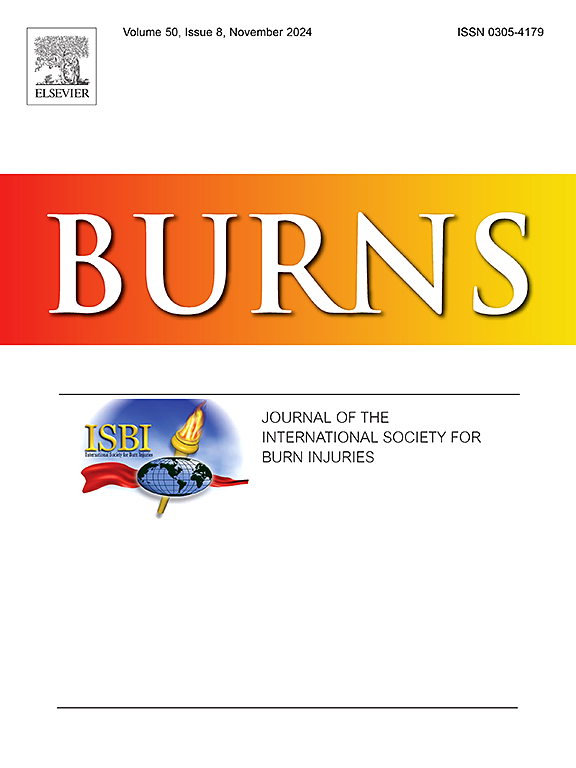单细胞测序分析和批量测序发现 IGFBP6 和 TNFAIP6 是烧伤后病理瘢痕的新型鉴别诊断标记。
IF 3.2
3区 医学
Q2 CRITICAL CARE MEDICINE
引用次数: 0
摘要
背景:烧伤后病理性疤痕(如瘢痕疙瘩和增生性疤痕)如果得不到准确的诊断和治疗,会导致不良的临床结果。然而,烧伤后病理性疤痕在分子水平上的鉴别诊断仍然有限。通过单细胞测序分析,我们研究了病理性疤痕在细胞水平上的遗传细微差别。本研究旨在确定分子诊断生物标志物,以区分烧伤后瘢痕疙瘩和增生性疤痕:方法:对单细胞测序、差异表达和加权共表达网络进行分析,以确定区分瘢痕疙瘩和增生性疤痕的潜在关键基因。我们从本中心收集了烧伤后的临床样本,以验证所确定的关键基因的表达水平:结果:单细胞测序分析显示,瘢痕疙瘩和增生性疤痕中分别有29个和30个细胞群,主要由成纤维细胞组成。大量差异基因分析显示,与增生性瘢痕相比,瘢痕疙瘩中有96个高表达基因和69个低表达基因。结合之前的研究,基因组富集分析(Gene Set Enrichment Analysis)选择成纤维细胞作为研究重点。根据单细胞数据,有 301 个基因在两种病理疤痕的成纤维细胞中稳定表达。同样,加权基因共表达网络分析显示,蓝色模块基因大多是与成纤维细胞相关的枢纽基因。在对单细胞数据中与成纤维细胞相关的基因、加权基因共表达网络分析-枢纽模块基因和大量差异表达基因进行交叉分析后,发现胰岛素样生长因子结合蛋白6和肿瘤坏死因子α诱导蛋白6是区分瘢痕疙瘩和增生性疤痕的关键基因,诊断准确率分别为1.0和0.75。免疫组化染色和定量反转录 PCR 显示,灼伤后瘢痕疙瘩中肿瘤坏死因子α诱导蛋白 6 和胰岛素样生长因子结合蛋白 6 的表达水平明显低于增生性疤痕--结论:肿瘤坏死因子α诱导蛋白6和胰岛素样生长因子结合蛋白6具有很高的诊断准确性,可为烧伤后病理性疤痕的鉴别诊断和治疗提供有价值的指导。本文章由计算机程序翻译,如有差异,请以英文原文为准。
Single-cell sequencing analysis and bulk-seq identify IGFBP6 and TNFAIP6 as novel differential diagnosis markers for postburn pathological scarring
Background
If not accurately diagnosed and treated, postburn pathological scars, such as keloids and hypertrophic scars, can lead to negative clinical outcomes. However, differential diagnosis at the molecular level for postburn pathological scars remains limited. Using single-cell sequencing analysis, we investigated the genetic nuances of pathological scars at the cellular level. This study aimed to identify molecular diagnostic biomarkers to distinguish between postburn keloids and hypertrophic scars.
Methods
Single-cell sequencing, differential expression, and weighted co-expression network analyses were performed to identify potential key genes for discriminating between keloids and hypertrophic scars. Postburn clinical samples were collected from our centre to validate the expression levels of the identified key genes.
Results
Single-cell sequencing analysis unveiled 29 and 30 cell clusters in keloids and hypertrophic scars, respectively, predominantly composed of fibroblasts. Bulk differential gene analysis showed 96 highly expressed genes and 69 lowly expressed genes in keloids compared to hypertrophic scars. By incorporating previous research, Gene Set Enrichment Analysis was conducted to select fibroblasts as the focus of research. According to the single-cell data, 301 genes were stably expressed in fibroblasts from both types of pathological scars. Consistently, Weighted Gene Co-expression Network Analysis revealed that the blue module genes were mostly hub genes associated with fibroblasts. After intersecting fibroblast-related genes in single-cell data, Weighted Gene Co-expression Network Analysis-hub module genes, and bulk differential expression genes, insulin-like growth factor binding protein 6 and tumour necrosis factor alpha-induced protein 6 were identified as key genes to distinguish keloids from hypertrophic scars, resulting in diagnostic accuracies of 1.0 and 0.75, respectively. Immunohistochemical Staining and Quantitative Reverse Transcription PCR revealed that the expression levels of tumour necrosis factor alpha induced protein 6 and insulin-like growth factor binding protein 6 were significantly lower in postburn keloids than in hypertrophic scars-
Conclusions
Tumour necrosis factor alpha induced protein 6 and insulin-like growth factor binding protein 6, exhibiting high diagnostic accuracy, provide valuable guidance for the differential diagnosis and treatment of postburn pathological scars-
求助全文
通过发布文献求助,成功后即可免费获取论文全文。
去求助
来源期刊

Burns
医学-皮肤病学
CiteScore
4.50
自引率
18.50%
发文量
304
审稿时长
72 days
期刊介绍:
Burns aims to foster the exchange of information among all engaged in preventing and treating the effects of burns. The journal focuses on clinical, scientific and social aspects of these injuries and covers the prevention of the injury, the epidemiology of such injuries and all aspects of treatment including development of new techniques and technologies and verification of existing ones. Regular features include clinical and scientific papers, state of the art reviews and descriptions of burn-care in practice.
Topics covered by Burns include: the effects of smoke on man and animals, their tissues and cells; the responses to and treatment of patients and animals with chemical injuries to the skin; the biological and clinical effects of cold injuries; surgical techniques which are, or may be relevant to the treatment of burned patients during the acute or reconstructive phase following injury; well controlled laboratory studies of the effectiveness of anti-microbial agents on infection and new materials on scarring and healing; inflammatory responses to injury, effectiveness of related agents and other compounds used to modify the physiological and cellular responses to the injury; experimental studies of burns and the outcome of burn wound healing; regenerative medicine concerning the skin.
 求助内容:
求助内容: 应助结果提醒方式:
应助结果提醒方式:


